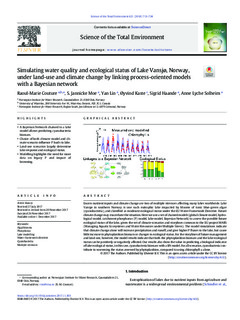| dc.contributor.author | Couture, Raoul-Marie | |
| dc.contributor.author | Moe, S. Jannicke | |
| dc.contributor.author | Lin, Yan | |
| dc.contributor.author | Kaste, Øyvind | |
| dc.contributor.author | Haande, Sigrid | |
| dc.contributor.author | Solheim, Anne Lyche | |
| dc.date.accessioned | 2019-01-07T11:14:39Z | |
| dc.date.available | 2019-01-07T11:14:39Z | |
| dc.date.created | 2018-10-31T17:52:33Z | |
| dc.date.issued | 2018 | |
| dc.identifier.citation | Science of the Total Environment. 2018, 621, 713-724. | nb_NO |
| dc.identifier.issn | 0048-9697 | |
| dc.identifier.uri | http://hdl.handle.net/11250/2579441 | |
| dc.description.abstract | Excess nutrient inputs and climate change are two of multiple stressors affecting many lakes worldwide. Lake Vansjø in southern Norway is one such eutrophic lake impacted by blooms of toxic blue-green algae (cyanobacteria), and classified as moderate ecological status under the EU Water Framework Directive. Future climate change may exacerbate the situation. Here we use a set of chained models (global climate model, hydrological model, catchment phosphorus (P) model, lake model, Bayesian Network) to assess the possible future ecological status of the lake, given the set of climate scenarios and storylines common to the EU project MARS (Managing Aquatic Ecosystems and Water Resources under Multiple Stress). The model simulations indicate that climate change alone will increase precipitation and runoff, and give higher P fluxes to the lake, but cause little increase in phytoplankton biomass or changes in ecological status. For the storylines of future management and land-use, however, the model results indicate that both the phytoplankton biomass and the lake ecological status can be positively or negatively affected. Our results also show the value in predicting a biological indicator of lake ecological status, in this case, cyanobacteria biomass with a BN model. For all scenarios, cyanobacteria contribute to worsening the status assessed by phytoplankton, compared to using chlorophyll-a alone. | nb_NO |
| dc.language.iso | eng | nb_NO |
| dc.publisher | Elsevier | nb_NO |
| dc.rights | Navngivelse 4.0 Internasjonal | * |
| dc.rights.uri | http://creativecommons.org/licenses/by/4.0/deed.no | * |
| dc.title | Simulating water quality and ecological status of Lake Vansjø, Norway, under land-use and climate change by linking process-oriented models with a Bayesian network | nb_NO |
| dc.type | Journal article | nb_NO |
| dc.type | Peer reviewed | nb_NO |
| dc.description.version | publishedVersion | nb_NO |
| dc.rights.holder | © 2017 The Authors | nb_NO |
| dc.source.pagenumber | 713-724 | nb_NO |
| dc.source.volume | 621 | nb_NO |
| dc.source.journal | Science of the Total Environment | nb_NO |
| dc.identifier.doi | 10.1016/j.scitotenv.2017.11.303 | |
| dc.identifier.cristin | 1625668 | |
| dc.relation.project | Norges forskningsråd: 244558 | nb_NO |
| dc.relation.project | EC/FP7/603378 | nb_NO |
| cristin.unitcode | 7464,30,23,0 | |
| cristin.unitcode | 7464,30,19,0 | |
| cristin.unitname | Nedbørfeltprosesser | |
| cristin.unitname | Ferskvannsøkologi | |
| cristin.ispublished | true | |
| cristin.fulltext | original | |
| cristin.qualitycode | 2 | |

